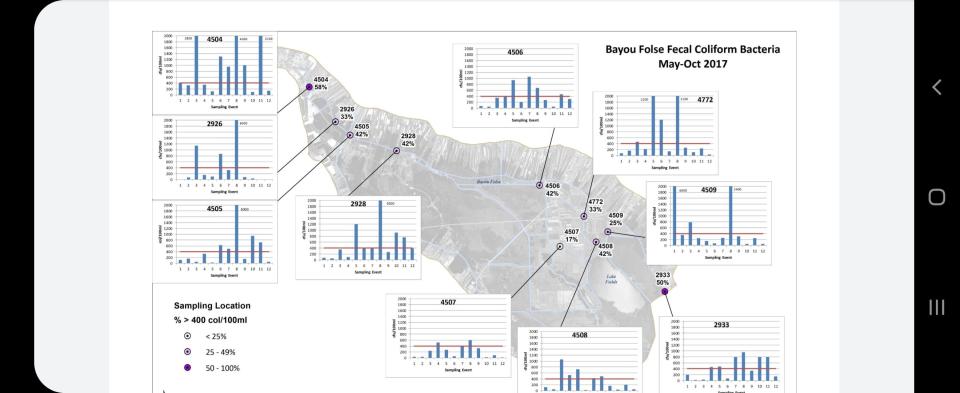Water samples from two areas in Bayou Folse still show high bacteria levels
Ongoing efforts since 2016 to improve the Bayou Folse Watershed's water quality have resulted in some victories. Two areas, however, are still showing some high concentrations of bacteria.
Barataria Terrebonne National Estuary Program and the Louisiana Department of Environmental Quality, as well as other government agencies, have led the improvement efforts.
The watershed encompasses Thibodaux, from Nicholls State University's campus, diagonally down, extending south of Lake Fields. The water quality had unsafe levels of fecal matter and very low levels of dissolved oxygen.
"Keep in mind, the standards for water quality in all of Louisiana, in all of the United States, are based on two main criteria, and that is fishable and swimmable," BTNEP Scientist Andrew Barron said.
Approximately 33,000 people live within the Bayou Folse Watershed. About 53% of the land is swamp or marsh, and the rest of the area is primarily for cattle (22%), developed (11%) or for agriculture (9%).

Efforts have mostly improved the fecal problems with only two sample sites still registering high bacteria concentrations, according to the data. Scientists such as Barron measure this by testing for fecal bacteria, such as E Coli. Some bacteria is to be expected as runoff from cattle will contain it as well as discharge from other wildlife, like birds.
The two high-registering bacterial areas are near Nicholls State University and the Country Club, due to sewage systems, and near the St. Charles Bypass, where it crosses Bayou Folse, due to cattle, Barron said.
More: Schriever party shooting leaves Raceland man dead and two injured
More: Thibodaux holds a special place for Tina Turner
If the number exceeds 400 colonies per 100 milliliters of water, it is deemed unsafe for swimming.
"What is 100 milliliters? That's not a big quantity… a cup is about twice as much as that, so it's about half a cup," he said. "What does that mean? There's 400 little seeds of bacteria in there that can start a colony… that's a highly concentrated soup of bacteria."
Drinking water isn't of concern in these situations because water is processed and treated before it is pumped to homes, but activities that expose people directly to the water, such as swimming, can put people into contact with pathogens.
Barron said the human waste problem is occurring because much of Louisiana has individual sewage systems. Systems like septic tanks and cesspools clean out the water by filtering the waste through the ground. Terrebonne and Lafourche landscape is close to the water table, meaning that often the sewage can be washed into the bayou before it has time to filter.
"According to the scientists and the Department of Health, those things are in contact with the groundwater, which is in direct contact with the nearby streams because we have a high groundwater table," he said. "Wastewater is dangerous because it contains all these pathogens, it contains viruses, it contains parasites, it contains bacteria, so it contains disease.
The Gulf of Mexico Division provided a $426,824 grant to aid in repairing and maintaining sewage systems with BTNEP. The grant provides up to $4,000 to repair or replace a sewage system.
Low dissolved oxygen levels are a different problem. The levels don't threaten people, but create poor conditions for aquatic life. Some fish are hardier than others, but generally speaking, fish require dissolved oxygen levels to live. By pushing the water through their gills, they extract the oxygen from the water and breathe.
The whole of the watershed still has low dissolved oxygen levels, according to DEQ Staff Scientist Aimee Preau, which makes for poor habitat for many fish species. Of the 115 field samples taken, one measured the highest at 14 mg, while many measured 2 mg or lower. A line chart shows the figures usually hovering about 5 mg or below. Healthy levels are generally between 6.5 and 8 mg.
"The oxygen dissolved in water is necessary for fish to respire, so when that gets really low, that body of water cannot support fish and wildlife in the water," Preau said. "In Bayou Folse it's expected that that low dissolved oxygen is due to nutrients."
The nutrients are due to nitrogen and phosphorus, primarily from fertilizer. About 7% of the watershed is dominated by sugarcane, but Preau said agriculture isn't the only contributor to the nutrients.
These nutrients enter the bodies of water through runoff. From there algae and other plant life feed off it. They bloom, eventually die, rot, and then bacteria feast on them. As the bacterium dine, they suck the oxygen from the water lowering the dissolved oxygen in the area and driving away fish.
This article originally appeared on The Courier: Water quality of two areas in Bayou Folse have high bacteria levels

